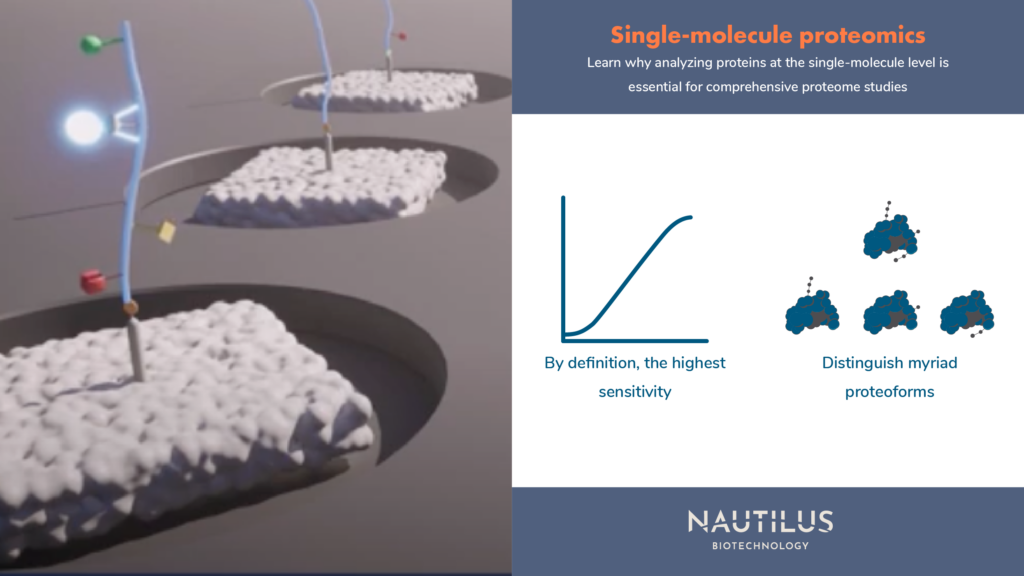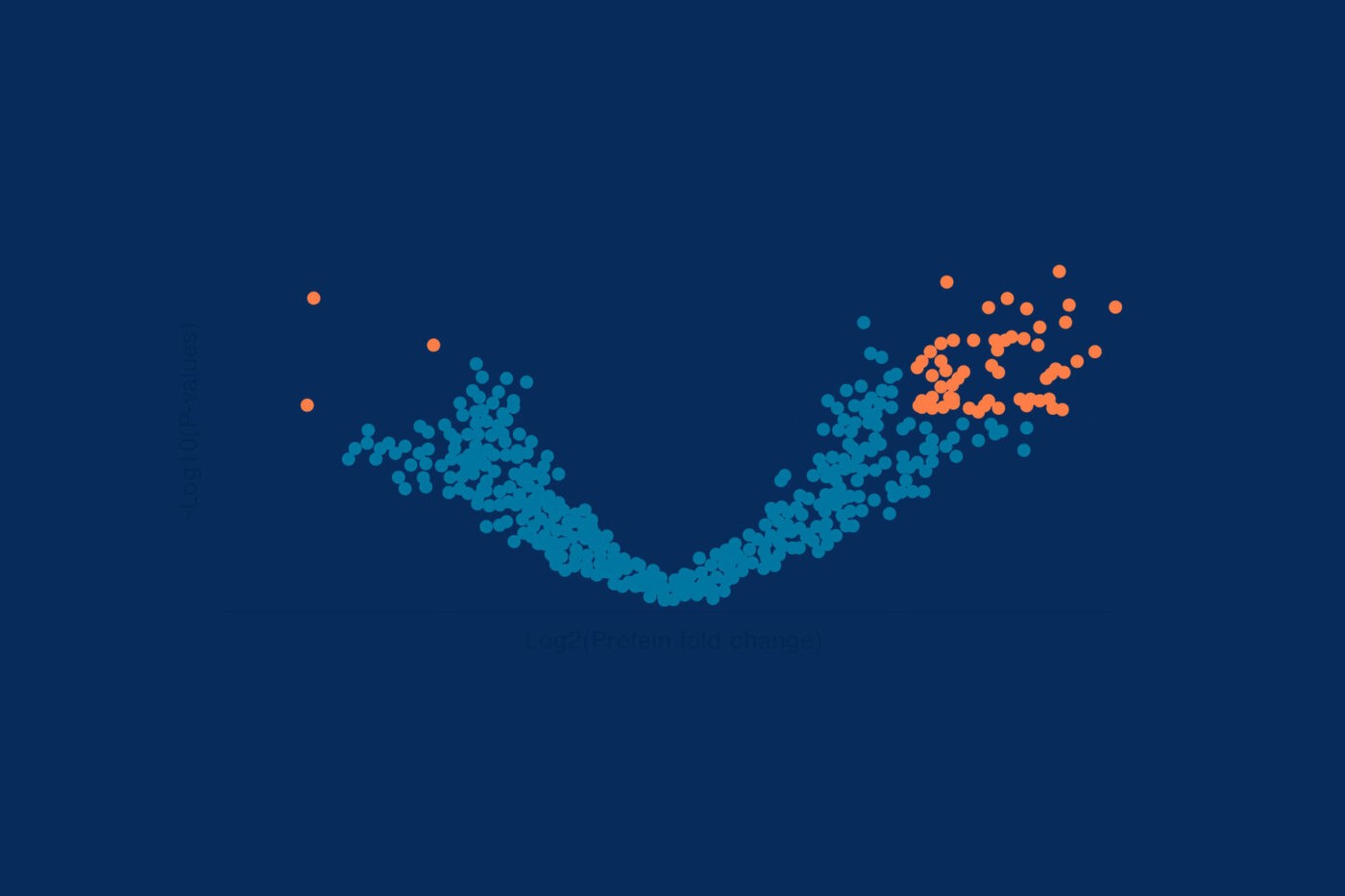
Single-molecule proteomics refers to proteomic analyses capable of detecting and differentiating signals coming from individual protein molecules. This revolutionary capability means scientists can find even extremely low-abundance proteins, which can often be missed by traditional proteomics techniques. Single-molecule proteomics has numerous applications, including in extending the reach of targeted proteomics studies that aim to find specific proteins in a sample, and targeted proteoform studies, which aim to identify all the ways single protein species are modified in a sample. Each proteoform is defined by the full set of modifications it has, whether those modifications come from alternative splicing, post-translational modification, or any other source. Thus identifying proteoforms requires single-molecule analysis of full-length proteins.
Read our preprint to explore novel proteoform data and its potential in drug development
You may have seen or heard the term “single-molecule” thrown around recent scientific papers and talks. While it can certainly be a buzzword, true single-molecule proteomics technologies have the impressive ability to interrogate their target analytes individually and independently. They provide information on each and every analyte rather than averaging information across a sample. Thus, their output data is provided at the greatest possible resolution. Single-molecule proteomic analyses reveal information that would be imperceptible through bulk measurement techniques that average out signals coming from multiple molecules (think measuring the intensity of a band in a western blot for instance).
Below we describe why single-molecule analysis is essential to get a complete picture of the proteome. In addition, we share how we’re designing the Nautilus Proteome Analysis Platform to provide single-molecule proteomic analysis at an unprecedented scale. We expect the Nautilus Platform to give researchers novel insights into the proteome, the mechanisms underlying disease, and the fundamental functions of life itself.
Watch this animation to learn how single-molecule analysis enables proteoform studies on the Nautilus Platform:
Advantages of single-molecule proteomics
Traditionally, proteomics technologies analyze proteins in bulk. That is, they assess proteins and their properties using technologies that measure signals coming from multiple proteins at once. These signals cannot be deconvoluted back to individual proteins. For example, in mass spectrometry, this comes in the form of identifying peptides derived from many proteins in the sample. However, it’s not usually possible to determine if the identified peptides came from the same original intact protein.
These bulk measurement proteomics technologies are useful in that they can identify abundant proteins, but single-molecule analyses can go further:
Single-molecule analysis provides the highest sensitivity
Bulk measurement proteomics technologies are rarely sensitive enough to confidently measure proteins present in small amounts. For example, to identify proteins with mass spectrometry, researchers may need to detect a certain number of peptides that bioinformatics tools can confidently associate with one protein species and no or few others. These proteomic techniques must therefore infer the identity of intact proteins from an assortment of peptides. With similar sequences across a variety of proteins and a lack of full protein sequence coverage, such inferences can be difficult to make and are sometimes inaccurate, especially for low abundance proteins.
Single-molecule proteomic analysis technologies are, by definition, able to detect the lowest amount of protein possible – a single protein molecule. These technologies are well-suited to quantify proteins across the wide dynamic range of the proteome.
Single-molecule analysis provides proteoform resolution
Proteins can be modified in many different ways to produce millions of proteoforms from thousands of genetically encoded protein species, and one proteoform can have multiple modifications. Technologies that detect such modifications in bulk samples usually cannot distinguish proteoforms with different sets of modifications from one another.
Technologies that assess modifications on intact proteins at the single-molecule level can theoretically identify all the specific modifications present on a single protein molecule. If these single-molecule proteomics technologies can interrogate single proteins in multiple ways either simultaneously or sequentially, they should be able to show researchers all the different ways single proteins are modified.
Issues with current proteomics technologies
There are a variety of next-generation single-molecule proteomic analysis methods. These all aim to achieve highly sensitive and comprehensive proteomic analysis as outlined above, but can have a few issues:
- The protein inference problem – Single-molecule protein sequencing technologies often sequence single-molecule peptides and not full length proteins. Like bottom-up mass spectrometry, they must infer full protein sequences from peptides and it will rarely be clear which peptides were from which original protein molecules. This makes it impossible to use these technologies to identify proteoforms because the peptides cannot be combined to identify the full-length single molecule proteins with their specific sets of modifications.
- Limited dynamic range – Many single-molecule proteomics platforms cannot cover the full dynamic range of the proteome. They cannot isolate enough peptides or intact proteins to reveal quantities of both high and low abundance proteins. For technologies that analyze peptides, this is a particular problem because they may need to isolate and analyze many peptides to infer the identity of a single protein.
- Destructive analysis – Many single-molecule proteomics platforms destroy proteins and peptides as they analyze them. Thus, these proteins and peptides cannot be re-analyzed to gain more information about them or to increase confidence in their identification.
Single-molecule proteomics on the NautilusTM Proteome Analysis Platform
We’ve designed the Nautilus Proteome Analysis Platform to achieve single-molecule proteomic analysis of intact proteins while avoiding the problems described above.
Advantages of single-molecule proteomics not he Nautilus Platform
- Intact protein analysis – On the Nautilus Platform, we aim to isolate individual, intact protein molecules and repeatedly interrogate them with fluorescent probes non-destructively. Such probes are designed to determine protein identity through our PrISM framework.
- Proteoform identification – In addition, probes designed to detect modifications can potentially detect all the ways single proteins are modified in targeted proteoform studies. Thus, with the Nautilus Proteome Analysis Platform we aim to enable researchers to interrogate even the rarest proteins and determine how they’ve been modified.
- High dynamic range – Importantly, we’re designing our platform with arrays that can accommodate up to 10 billion single-molecule protein landing pads that can be imaged independently. With super-Poisson loading, these arrays are designed to be highly occupied by billions of proteins during every sample run. This should enable researchers to use broadscale proteomics to identify proteins across the majority of the dynamic range of the proteome for most sample types.
With this single-molecule proteomics technology, we aim to provide researchers with unprecedented access to the proteome. We hope this will enable a revolution in biological research with applications across basic research, neuroscience, oncology, drug development, biomarker discovery, and much more!
MORE ARTICLES


